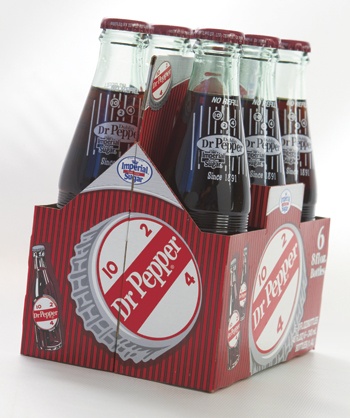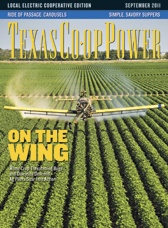My friend Todd Hilliard speaks in the hushed tone reserved for rare and sacred things: “Do you want to see the bottles?”
I do. He opens the trunk of his car, and there they are—24 glass bottles, glinting in a flood of sunlight. They’re scuffed, scratched and old—three decades old—the same age as Todd and me.
I pull one of them from a wooden crate. It’s heavy. It bears a logo that hasn’t appeared on the side of a Dr Pepper bottle since the 1980s: Dr Pepper in white letters on a red oval in the upper left corner and below, Dr Pepper in larger white letters along a diagonal red stripe against a maroon background.
The sight and feel evoke childhood memories of hot Texas afternoons prying off bottle caps and wiping away slushy condensation.
“Just like I remember,” I say, and I put it back with the others.
These bottles are all empty, and they seem old and tired. But not for long. That’s because Todd, who lives in Austin, is driving them to Dublin, where the Dublin Dr Pepper Bottling Company will exchange them for filled bottles. The returned empties go into rotation, where machine-bottling equipment will pour new life into them.
Dublin, about 80 miles southwest of Fort Worth, is home to the oldest and longest continuously operating Dr Pepper bottling facility in the world. America’s oldest major soft drink was invented by a pharmacist in Waco in 1885, and in 1891, the Dublin facility was the first plant built specifically to bottle Dr Pepper.
There are more than 170 Dr Pepper bottlers in the United States and Canada. In the 1970s and 1980s, those operations and others in the soda industry began to sweeten their drinks with high-fructose corn syrup, a substitute for more costly sugar. But the Dublin Dr Pepper plant never stopped using the traditional sweetener: Imperial Pure Cane Granulated Sugar. Today, the Dublin plant continues to churn out original-formula Dr Pepper as well as a handful of other old-fashioned soft drinks—SunCrest Orange, Triple XXX Root Beer, NuGrape and Big Red.
These days, though, Dublin’s machinery is so exhausted—its newest piece of equipment was produced in 1965—that it only operates one day each month, typically the third Wednesday (if you want to see the operation, call before heading out). Soapsuds flow across the concrete floor as an antiquated assembly line washes old glass bottles like the ones Todd owns. Then the contraptions wheeze and whir as they spurt in a dollop of syrup, slowly mix in the carbonated water, punch on a bottle cap and mix it all up into a tasty concoction.
But there’s a catch: Dublin’s legendary bottling apparatus only works on sturdy returnable glass bottles—which Dr Pepper stopped making in 1993, in favor of lightweight and flexible, nonbreakable plastic. While you can still buy Dublin Dr Pepper in a 12-ounce aluminum can or a small, nonreturnable 8-ounce glass bottle, those beverages are filled at an off-site Central Texas plant and then sent back to Dublin.
As Todd puts it, “If you want to truly experience the stuff that comes out of Dublin’s old-timey bottling machine, you’ve got to have old-timey bottles.”
That old-timey machine-bottling equipment in Dublin draws people from all of Texas and beyond who bring their old Dr Pepper bottles by the case and exchange them for filled ones for a nominal fee: It costs $16 to swap out a case of 10-ounce bottles and $15 to swap out a case of 61/2-ounce bottles. Generally speaking, the bottles can be swapped for the same or similar designs from the same era, depending on what the plant has available.
Twice a year, a lawyer from Brownsville—nearly 500 miles away—hauls 25 cases to be exchanged, according to Lori Dodd, Dublin’s special events coordinator. Another family drives down from Missouri. A guy in Illinois comes by once a year to trade in his empties.
These people are so enamored of Dr Pepper, they have a fan club with about 250 dues-paying member-families, an annual convention, a newsletter and a page on the Dublin Dr Pepper website.
Bill R. Hall, president of the Dr Pepper 10-2-4 Club, lives 150 miles away from Dublin in Taylor. He remembers the day in the late 1980s when he first called the Dublin plant. He said, “I’m coming out with 50 cases.”
“And they switched ’em all out or refilled ’em for me,” he said. The process took the better part of a morning. Then “I loaded up that Dr Pepper from one end of my Suburban to the other and drove back to Taylor. They rattled the whole way back. It was like music.”
So why do people travel such great distances for this particular soft drink? Not surprisingly, the folks in Dublin credit a superior product. Every Dr Pepper starts with the same base, a concentrated formula that is manufactured at a plant in St. Louis, Missouri, and then shipped to independent bottlers around the U.S. and Canada. But only Dublin and a handful of other bottling plants use real cane sugar instead of the cheaper corn syrup.
And, depending on what’s in stock, only Dublin lets people drink from the same bottles they remember from childhood—whether it’s a “Good for Life!” bottle from the 1920s through the 1940s or an “I’m a Pepper” bottle that was introduced in the 1970s.
“There’s just something about the experience and taste of a Dublin Dr Pepper after it’s been chilled in those heavy glass bottles that should never, ever cease,” Dodd says.
——————–
Wes Ferguson is a frequent contributor to Texas Co-op Power.
Editor’s Note: At press time, Dublin Dr Pepper is being sued by Dr Pepper Snapple Group Inc.—which owns the brand and licenses sales territory—over trademark rights violations and sales outside the approved territory.


